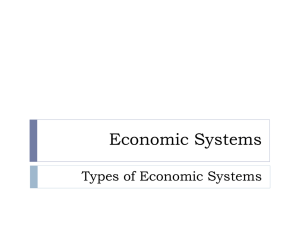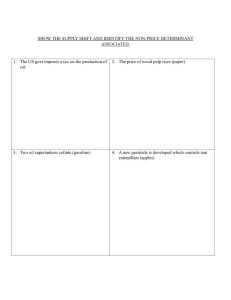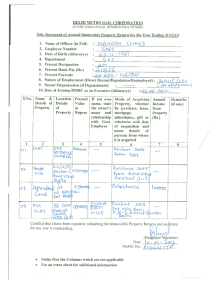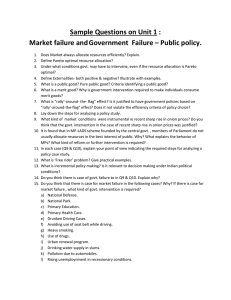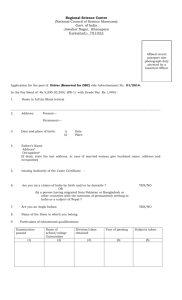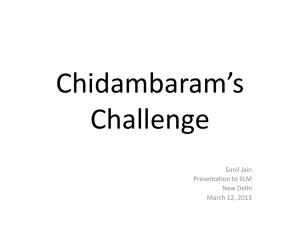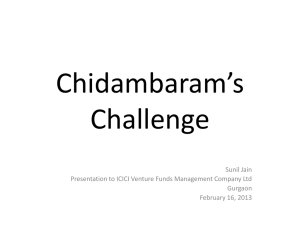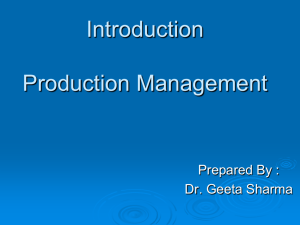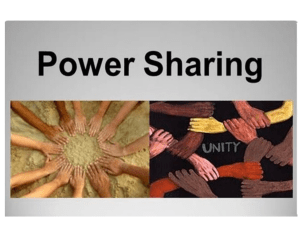Chapter 12: The Media
advertisement
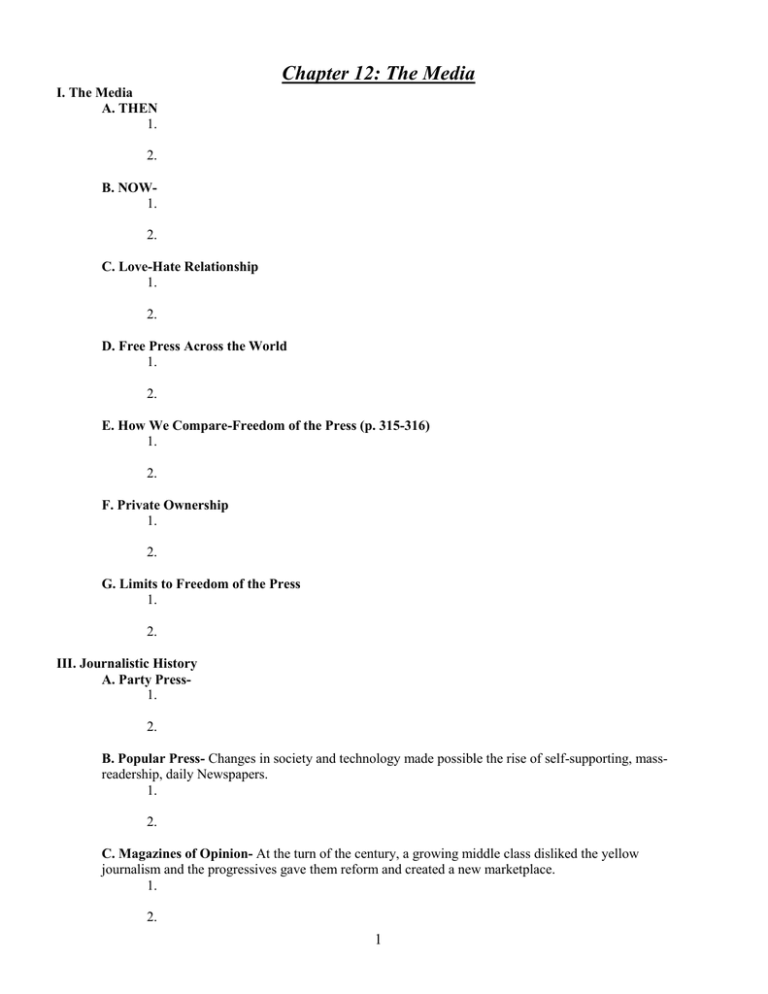
Chapter 12: The Media I. The Media A. THEN 1. 2. B. NOW1. 2. C. Love-Hate Relationship 1. 2. D. Free Press Across the World 1. 2. E. How We Compare-Freedom of the Press (p. 315-316) 1. 2. F. Private Ownership 1. 2. G. Limits to Freedom of the Press 1. 2. III. Journalistic History A. Party Press1. 2. B. Popular Press- Changes in society and technology made possible the rise of self-supporting, massreadership, daily Newspapers. 1. 2. C. Magazines of Opinion- At the turn of the century, a growing middle class disliked the yellow journalism and the progressives gave them reform and created a new marketplace. 1. 2. 1 D. Electronic Journalism- Radio came onto the scene in the 1920’s, television in the 1940’s 1. Fireside Chats- during the Great Depression, FDR eased the fears of the nation w/ his weekly 2. 3. E. The Internet- The newest electronic source of new is the Internet 1. 2. 3. IV. The Structure of the Media A. The Relationship 1. 2. B. Degree of Competition1. 2. C. The National Media 1- Includes the wire services, Magazines such as Times, Newsweek, and US News and World Report as well as newspapers such as USA Today, Wall Street Journal and the New York Times and Washington Post somewhat. a. Wire services supply most of the national news that local papers publish b. Many TV and Internet news stories come from these national media c. Two reasons why they are important 1. Government officials pay close attention to what these media say about them and their programs 2. They differ from local media and are better informed, trained, and paid 2. D. National Media Roles 1. Gatekeepera. b. 2. Scorekeepera. b. Horse-Race Coverage- Focuses on “Winners” and “losers” and who is ahead rather than the issues in a particular race 1. Makes early primaries very important to being elected president 2. Front Runner- Early leader 3. Iowa and New Hampshire 3. Watchdoga. b. 2 V. Print Media Rules A. 1st Amendment- “Congress shall make no law abridging the freedoms …of the press” 1. The press is given more rights in the United States than anywhere else in the world B. Prior Restraint1. 2. Editors and publishers are free to decide content rather than the government C. Libel1. 2. The person suing must show that that article was printed maliciously with reckless disregard for its truth or falsity 3. There is no law against criticizing public personas and since government officials are public personas, it is difficult to win these cases D. Confidentiality of Sources- Many states have passed laws protecting journalists from revealing confidential sources. 1. In other states, the courts must decide whether the protection of these sources outweighs the interest of gathering evidence in a criminal investigation. 2. In general, the Supreme Court has upheld the right of the government to compel reporters to divulge information as part of a properly conducted criminal investigation. E. Shield Laws1. 2. Privacy Protection Act of 1980- prevents all levels of government from conducting surprise searchers of newsrooms; except in a few special circumstances 3. 2005-CIA: F. National Security- Government tries to control the information concerning national security by classifying certain information as secret and by limiting press coverage of military action 1. NY Times v. US: a. G. Landmark Cases 1. 2. 3. VI. Regulating Broadcasting A. FCC- The federal govt. regulates the broadcast media much more strenuously than the Print 1. There are a limited number of radio and TV airwaves and Interstate Commerce Clause 2. Comprised of a 5 member parcel- President appoints, senate approves 3. Cannot influence content but can threaten not to renew the licenses which are renewable every seven years B. Deregulation- There has been a push in recent years to deregulate the broadcast media 1. Television is still highly regulated but not radio which has caused centralization of media control. C. Equal Time Rule1. 2. All candidates must be allowed to buy equal time to ensure equality 3 D. Campaigning 1. 2. 3. Made it much easier for political unknowns to become serious candidates for office a. Jimmy Carter and Ronald Reagan b. Less party dependent 4. Increased the amount of Money needed to run for president a. 1st political advertisement (1952) Dwight Eisenhower v. Adlai Stevenson b. Nixon v. JFK debate c. Candidates for office must be telegenic to get elected VII. Are the National Media Biased A. A Liberal Majority 1. 2. 3. B. Neutral and Objective? 1. 2. 3. C. Media’s Influence 1. 2. 3. 4. TET OffensiveD. How to Read a Newspaper (p. 312) 1. Coveragea. 2. Sourcesa. Trial Balloon: 3. Languagea. VIII. Government and the News A. Maxims of Media Relations (p. 315) 1. 2, 4 B. Prominence of the President1. The person w/ the largest podium in all of government is the president and with so much attention on this single individual, he is able to shape public opinion 2. Theodore Roosevelt was the first President to raise the systematic cultivation of the press a. Bully Pulpit- “Most of us enjoy preaching, and I’ve got such a bully pulpit.” 3. Through pre-made news briefings and scripted press conferences, the Whitehouse is able to determine in large part what information the press and American people know a. job of the Press Secretary C. Coverage of Congress 1. there are 535 congressmen that must compete for the spotlight and no one congressman can speak for the collective whole a. Additionally, most work takes place in committees and outside of congress so the dramatic events that captivates audiences does not occur 2. Media focuses on respective party leaders and major congressional events such as Confirmation Hearings and Oversight Activities 3. C-SPAN- To close the gap between the executive branch and legislative branch coverage’s they have allowed cameras in both congressional chambers D. Behind the Curtain- The Brethren 1. Because of the remoteness of the judges and the technical nature of the issues, the judicial branch receives the least coverage E. Why do We Have so Many Leaks 1. 2. IX. Media & Government A. Adversarial Position- The U.S. govt. and the media have developed a very fine love/hate relationship; they need to work together but their positions force them to be adversaries 1. Officials need the media to reach the public and convince them on the merits of their policies 2. Journalists need sources and the news from politicians 3. 4. B. Attack Journalism/Muckraking- searching out and reporting news stories that expose major scandals involving prominent people 1. The watchdog role of the media on the federal govt. 2. To handle the media almost every department in the govt. has someone or some group responsible for dealing w/ the press a. The department of defense employs 1500 people to handle relations w/ the media 3. D. Sensationalism 1. 2. E. Government Constraints1. 2. 5


